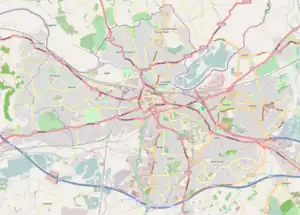| Clayfield Copse | |
|---|---|
 Pig Sculpture from fallen tree in Clayfield Copse on April 2017 | |
 Location within Reading | |
| Type | Local nature reserve |
| Location | Caversham, Reading, UK |
| Coordinates | 51°29′19″N 0°57′25″W / 51.4886°N 0.9570°W |
| Area | 8.65 hectares (21.4 acres) |
| Created | 1991 |
Clayfield Copse is a local nature reserve on the northern edge of the suburb of Caversham in Reading, UK. The site is 8.65 hectares (21.4 acres) in size and is a natural open space consisting of fields, wild flower meadow and native woodlands adjoining the Oxfordshire countryside. Some of the woodland is being actively managed as hazel coppice, and traditional dead hedging defines some of the ancient woodland areas.[1] The site is the only outcrop of London Clay north of the River Thames in Reading and makes up the southern tip of the Chiltern Hills. The nature reserve is under the management of the Reading Borough Council.[2][3][1][4]
The site also features a sculpture trail.[3]
History

Clayfield Copse used to be part of the country house estate of Caversham Park. In 1991, the site was designated a local nature reserve, making it Reading's first such reserve.[1][4]
Fauna
The site has the following fauna:[5][6]
Birds
Flora
The site has the following flora:[6]
Trees
Plants
- Anemone nemorosa
- Ranunculus auricomus
- Ranunculus ficaria
- Viola reichenbachiana
- Viola riviniana
- Alliaria petiolata
- Cardamine pratensis
- Lunaria annua
- Primula veris
- Primula vulgaris
- Ribes rubrum
- Euphorbia amygdaloides
- Mercurialis perennis
- Geranium robertianum
- Sanicula europaea
- Symphytum orientale
- Stachys sylvatica
- Glechoma hederacea
- Veronica hederifolia
- Veronica montana
- Scrophularia nodosa
- Lonicera periclymenum
- Hyacinthoides non-scripta
- Ruscus aculeatus
- Cornus sanguinea
- Daphne laureola
- Melica nutans
- Carex pendula
- Carex sylvatica
Fungi
References
- 1 2 3 "Reading Borough Council". Reading.gov.uk. 13 February 2017. Retrieved 10 April 2017.
- ↑ "Magic Map Application". Magic.defra.gov.uk. Retrieved 10 April 2017.
- 1 2 "Natural England - Special Sites". Lnr.naturalengland.org.uk. Retrieved 10 April 2017.
- 1 2 "Friends of Clayfield Copse". Econetreading.org.uk. Retrieved 10 April 2017.
- ↑ "Birdwatchers in a twitter as golden oriole flies in". Get Reading. Retrieved 10 April 2017.
- 1 2 "Clayfield Copse – 15 April 2012 « Reading & District Natural History Society". Rdnhs.org.uk. Retrieved 10 April 2017.